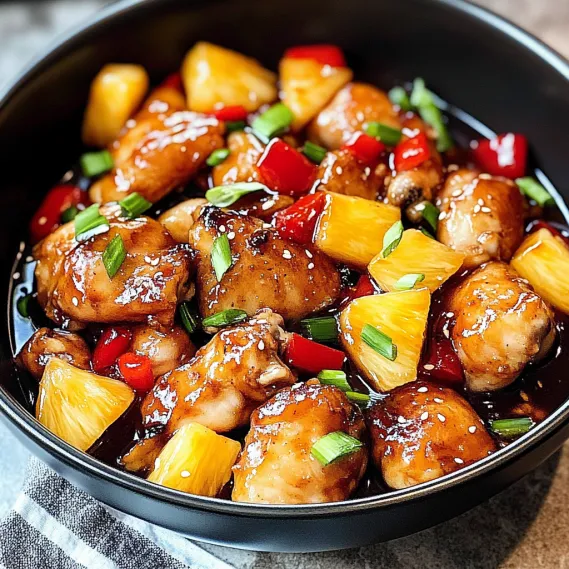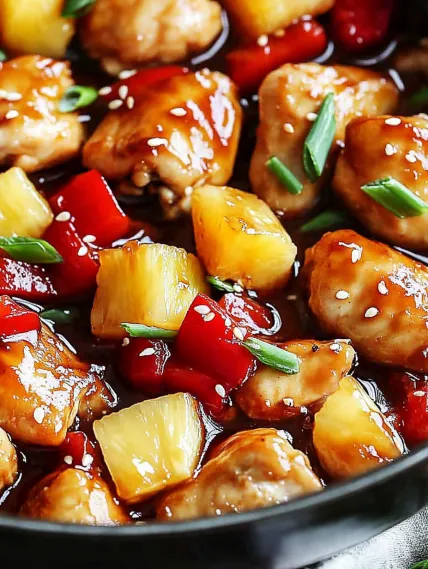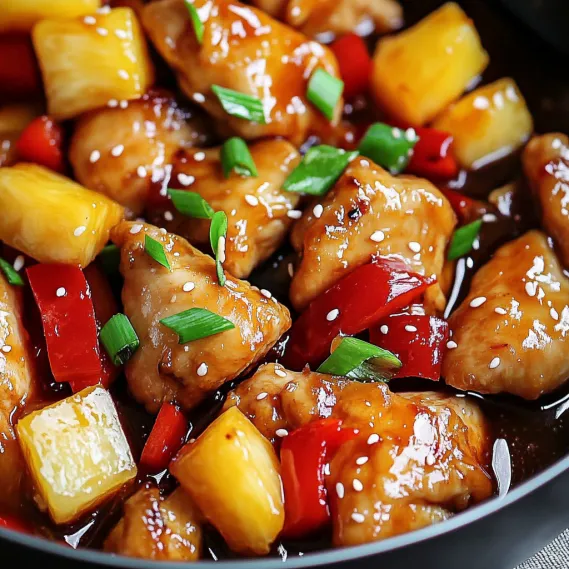 Pin
Pin
This homemade pineapple chicken delivers irresistible sticky sweetness that surpasses any takeout version while coming together in just minutes. The combination of tender chicken pieces with fresh bell peppers and juicy pineapple creates the perfect balance of savory and sweet. Each bite offers incredible texture and flavor that satisfies those takeout cravings without leaving home. The signature sauce coats everything beautifully, creating that restaurant-quality experience that makes ordinary rice extraordinary just by soaking up these amazing flavors.
I created this recipe after watching my family repeatedly order the same dish whenever we got Chinese takeout. Realizing how much money we could save by making it at home, I experimented until perfecting this version. The first time I served it, my husband actually preferred it to our regular restaurant version, saying the sauce had more depth and the chicken stayed juicier. Now we enjoy this whenever cravings strike without waiting for delivery.
Essential Ingredients and Selection Tips
- Chicken Thighs: Boneless skinless varieties provide ideal moisture and richness. Select pieces with good color and minimal fat for best results.
- Bell Peppers: Red varieties add vibrant color and natural sweetness. Look for firm, glossy specimens with bright color and crisp texture.
- Fresh Ginger: Creates essential aromatic foundation. Choose pieces with tight skin and spicy fragrance when broken.
- Pineapple Chunks: Provides tropical sweetness and gentle acidity. Canned varieties packed in juice offer convenience while fresh provides superior texture.
- Hoisin Sauce: Delivers rich umami backbone to the sauce. Authentic brands contain fewer additives for cleaner flavor.
I've found that splurging on higher-quality hoisin sauce makes a noticeable difference in the final flavor. The extra dollar or two is worth it for the added depth and authenticity it brings to this simple dish.
Detailed Cooking Instructions
- Step 1: Prepare With Precision
- Season diced chicken thighs with kosher salt and freshly ground black pepper. Heat a combination of sesame oil and olive oil in a large skillet over medium-high heat until shimmering. Add chicken pieces without crowding and allow to brown on all sides until golden crust forms.
- Step 2: Create Aromatic Base
- Add minced garlic and freshly grated ginger to partially cooked chicken. Stir continuously for thirty seconds until incredibly fragrant but not browned. Introduce diced red bell peppers and continue cooking until peppers begin to soften slightly.
- Step 3: Build Signature Sauce
- Add pineapple chunks and reserved juice to the skillet. Introduce hoisin sauce, low-sodium soy sauce, honey, and chicken broth. Stir everything together while bringing to gentle simmer and allow flavors to meld together.
- Step 4: Perfect Consistency
- Create slurry by whisking cornstarch and cold water together until completely smooth. Pour mixture into simmering sauce while stirring constantly. Continue cooking until sauce thickens noticeably and develops glossy appearance.
- Step 5: Add Finishing Touches
- Ensure chicken is completely cooked through with no pink remaining. Adjust seasoning to taste with additional soy sauce or honey if needed. Remove from heat and scatter sliced green onions and toasted sesame seeds over top before serving.

I particularly enjoy serving this dish in hollowed pineapple boats when entertaining guests. The presentation always impresses everyone while requiring minimal additional effort. My mother insists on doubling the sauce recipe because she loves having extra to spoon over her rice. The aroma that fills the kitchen while making this always transports me back to childhood visits to our favorite Chinese restaurant.
Sauce Secrets Revealed
The signature sauce truly defines this dish with its perfect balance of sweet, savory, and tangy elements. I discovered through trial and error that the exact ratio of ingredients makes all the difference. Too much honey creates a cloying sweetness that overwhelms the dish, while too little results in a sauce that doesn't achieve that beautiful sticky quality. The pineapple juice provides natural acidity that balances the sweetness, while the combination of hoisin and soy creates that umami foundation.

Perfect Pairings
After years of serving this dish, I've found that jasmine rice makes the ideal base for soaking up all that magnificent sauce. For a lower-carb option, cauliflower rice works surprisingly well, especially when seasoned with a touch of sesame oil before serving. When entertaining, I like to create a complete Chinese restaurant experience by starting with a simple egg drop soup and offering fortune cookies for dessert. My children love helping write personalized "fortunes" for our guests, adding a special touch to the meal.
Mastering the Techniques
The first few times I made this dish, I struggled with getting the sauce consistency just right. I've since learned that the cornstarch slurry is truly essential - it transforms the thin, watery base into that restaurant-style sauce that clings beautifully to every bite. The key is to mix the cornstarch with cold water until completely smooth before adding to the hot pan. Another technique I've perfected is the initial searing of the chicken. Allowing the pieces to develop a golden crust before adding liquids creates another layer of flavor through caramelization. When I'm in a hurry and skip this step, the difference in the final dish is noticeable.
Versatile Variations
While the classic version remains our family favorite, I've created several variations that have earned their place in our regular rotation. For spice lovers, adding Thai bird chilies or a teaspoon of sambal oelek creates pleasant heat that balances the sweetness perfectly. During summer months when our garden is producing, I often add snow peas or sugar snap peas for extra crunch and color. For special occasions, I've created a "surf and turf" version by adding large shrimp during the last few minutes of cooking - the shrimp pick up the sauce flavors beautifully while adding elegant presentation value.

Chef's Helpful Tips
- Pat chicken pieces completely dry before seasoning and cooking for better browning and crisper edges
- Keep ingredients prepped and ready before starting, as this dish comes together quickly once cooking begins
- For deeper flavor, toast sesame seeds in a dry pan until golden before using as garnish
- When using canned pineapple, choose chunks packed in juice rather than syrup for better flavor balance
- For maximum sauce coverage, let the finished dish rest for 2-3 minutes before serving
Recipe FAQs
- → Can I use chicken breast instead of thighs?
- Yes, boneless skinless chicken breast works well, just be careful not to overcook it as it can dry out more quickly than thighs.
- → Can I use fresh pineapple instead of canned?
- Fresh pineapple works great - use about 2 cups of chunks and substitute bottled pineapple juice or additional chicken broth for the sauce.
- → What can I substitute for hoisin sauce?
- Mix equal parts of soy sauce and brown sugar with a dash of five-spice powder if available, or use oyster sauce with a little honey.
- → Is this recipe gluten-free?
- The recipe contains soy sauce and hoisin sauce which typically contain gluten - use tamari and gluten-free hoisin sauce for a gluten-free version.
- → What else can I serve with this besides rice?
- This goes well with cauliflower rice, quinoa, rice noodles, or even inside lettuce wraps for a lower-carb option.
